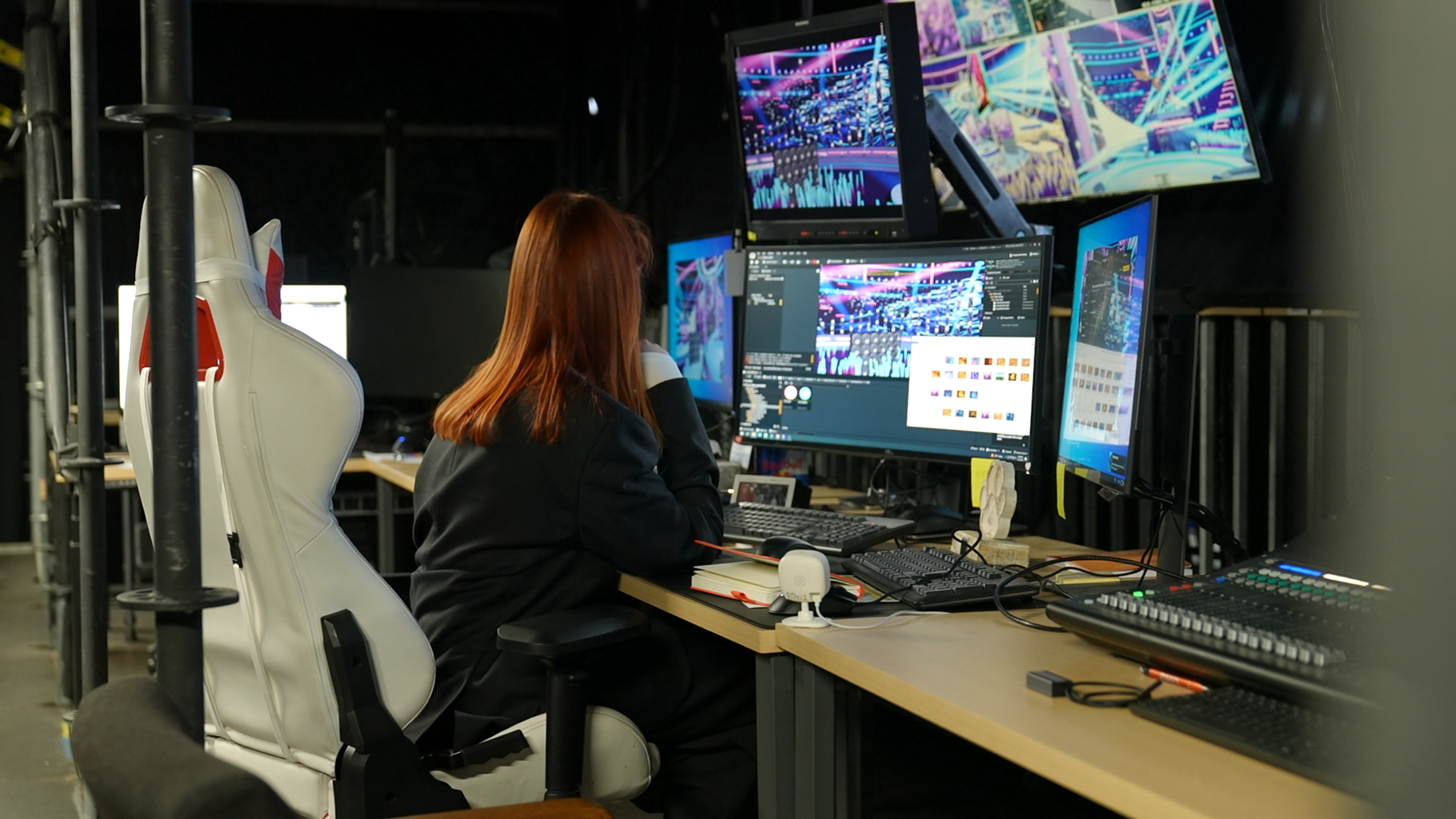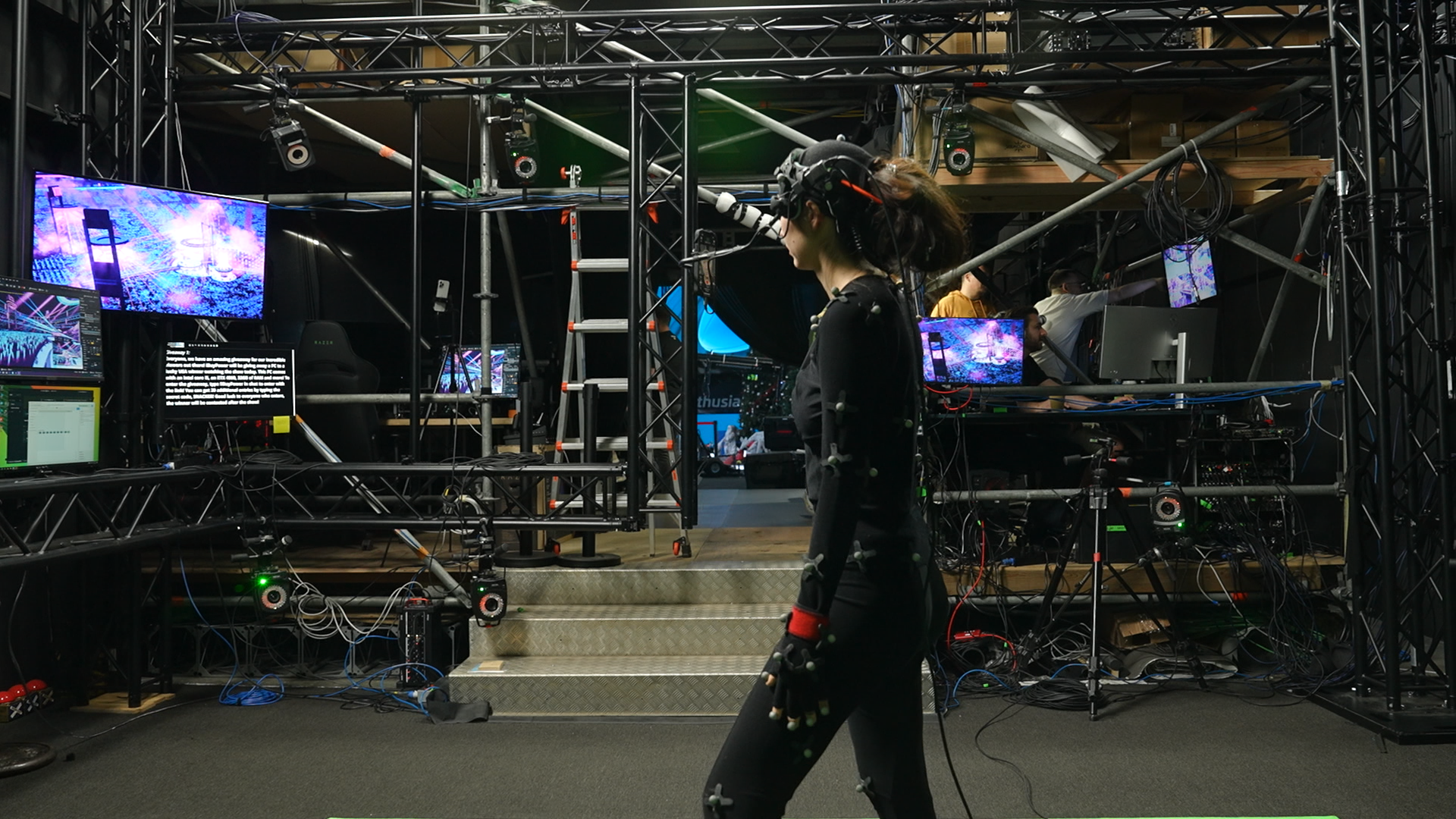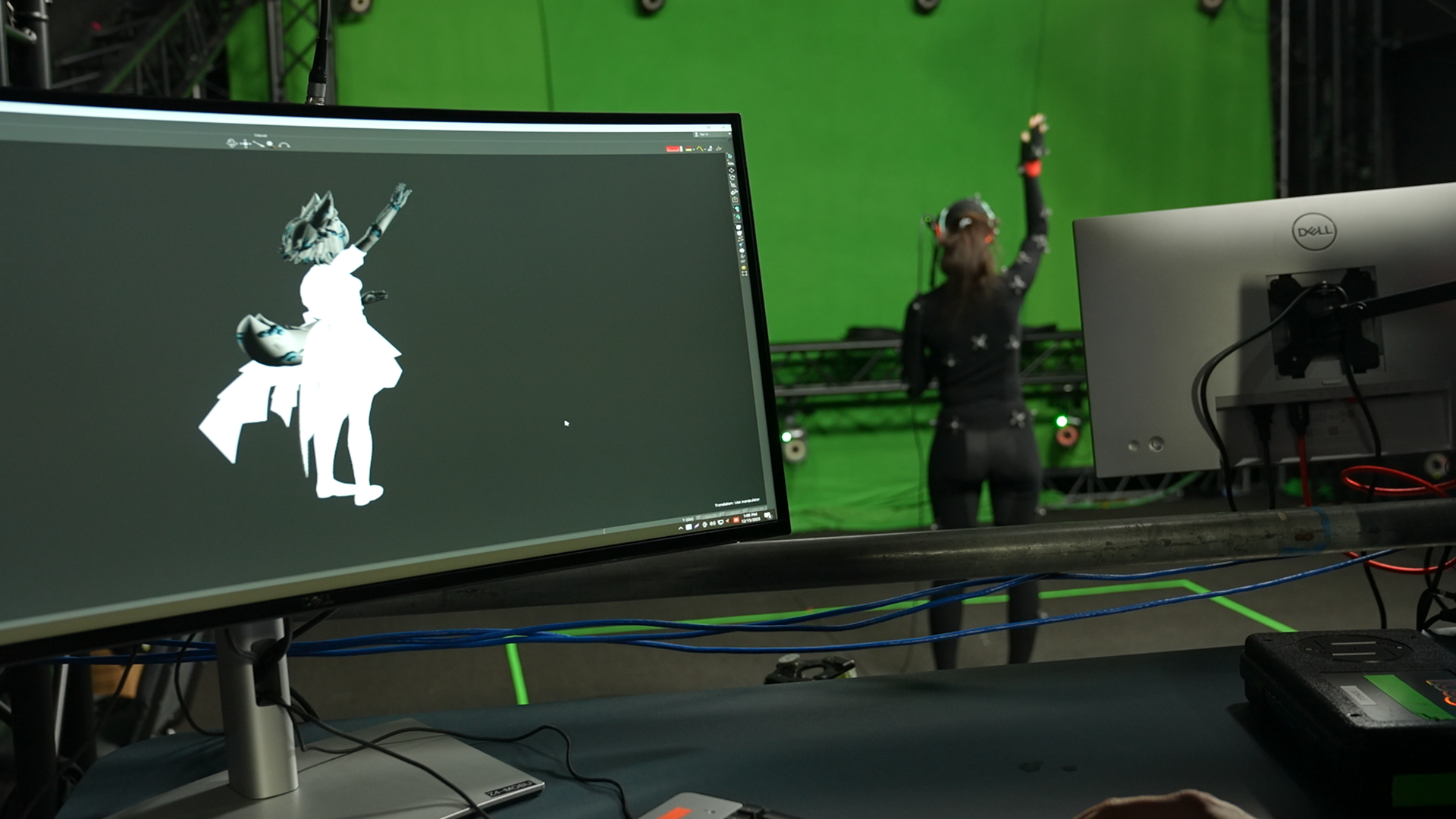On stream, Filian took the stage at the center of a colossal arena, lit with violet spotlights and surrounded by crowds of fans holding lightsticks. The streamer opened the show dressed in a vivid purple skirt, magenta bow tie and high white boots that matched her jacket — a ritzy version of her avatar’s usual sailor-style school uniform.
“Please be patient with us. This show has a lot of tech … it’s as live as it comes,” Filian said during her opening remarks. “It’s not rocket science, but it could be.”
Filian, a streamer with over 766,000 Twitch followers, hosted the first annual VTuber Awards last weekend. Like many VTubers — a portmanteau of “virtual YouTuber” — Filian keeps her identity secret, and instead of showing her real face, streams using a digital model.
Filian was physically hosting the ceremony from an enclosed green box in WePlay’s Los Angeles studio, a space typically used for esports events. The virtual reality awards show is one of the first of its kind — both for WePlay, a production company that has mainly focused on hosting and producing in-person gaming tournaments in its Los Angeles and Kyiv studios over the last decade, and for VTubing, which has grown from a niche streaming genre to a billion-dollar industry in recent years.

The show was a first for VTubers and WePlay, the company that produced the live VR event. Image Credits: The VTuber Awards

The event blended WePlay’s physical production space with a VR stadium. Image Credits: The VTuber Awards
VTubers have been broadly recognized in other shows; the Streamer Awards includes a category for “Best VTuber,” and at this year’s Game Awards, VTuber Ironmouse made history by being the first animated streamer to win Content Creator of the Year. But neither award show accounts for the skills unique to VTubing, like avatar design, technological innovation and hosting virtual events.
The award for best tech VTuber, for example, went to Vedal987, a streamer and programmer who developed the chatbot VTuber Neuro-sama, which uses text-to-speech and AI to play games and communicate with Twitch viewers.
“In every awards show, VTubers are often a footnote or sometimes treated as a unique, strange thing, and so the idea for these awards is like, ‘Why not have a show for ourselves?’” Filian told TechCrunch in an interview in the days leading up the show.
VTubers, who typically present with animal ears, exaggerated features or raunchy outfits, are often written off as lewd anime streamers. The genre started in Japan in the early 2010s as an offshoot of idol culture, and took off outside of Asia when VTuber production company Hololive debuted its first English-speaking streamers. Filian noted that the awards show also acknowledges VTuber viewers as much as individual content creators, since fans drove the genre’s breakthrough to mainstream recognition. In addition to the category for most dedicated fanbase, the VTuber Awards also includes a category for VTuber clippers, who clip, curate and post VTuber content online.
“And so what these people would do is post to YouTube, and in many ways, they created a massive demand for VTubers,” Filian continued. “When VTubers finally came to the west, it was primed to explode. It can’t be overstated how important VTuber clippers are and were to VTubers being where they are today … In many ways, VTubers are typically a lot more involved with their fans than a lot of other creators are.”
The show was a technical feat as well. The five-hour event married WePlay’s physical production space with countless hours of engineering and design. Though WePlay has used augmented reality elements in previous live productions, the awards show was the first fully virtual event that the company has produced. WePlay’s Chief Marketing Officer Iryna Chuhai pointed out that for the film and video game industry, using this scale of mocap technology is an “ordinary event.” Incorporating it into a live production, however, is more challenging.
Planned in partnership with Mythic Talent, a management company that represents VTubers including Filian, the event was initially going to take place on a physical stage with “screens and graphics” to accommodate VTubers, WePlay’s Chief Visionary Officer Maksym Bilonogov told TechCrunch before the show.
“But then we realized it’s not the way, it’s not the right philosophy,” Bilonogov said. “Because it’s VTubers, it should be a fully virtual space. So we started building the technology to make it real, so the real cameraman using the real camera can shoot the virtual world.”

Each physical camera could capture multiple angles in VR. Image Credits: WePlay Studios
The stream depicted a vast arena, but Filian’s avatar was essentially confined to a smaller circular stage surrounded by screens, which was a virtually constructed version of WePlay’s physical production stage. In real life, camera operators controlled three cameras linked to virtual angles, so that each physical pan, tilt and focus pull was reflected in the virtual broadcast. The physical operators could switch between multiple different angles in the stadium using iPads connected to the cameras, so that the production appeared to use at least a dozen cameras instead of just three. The physical lights on the stage were connected to corresponding virtual lights, so that WePlay could control the stadium’s spotlights by activating the real ones. WePlay also connected Resolume, a software for live event visuals, to the virtual venue to control the graphics that played on the VR stage’s screens.
“From a visual perspective, from the technology, it’s fully new for us,” Bilonogov continued. “We’re learning a lot. I can say that it’s the hardest technological project for WePlay. It’s fully virtual reality with virtual cues.”

Motion capture technology is not new to the film and video game industries, but incorporating it into a live streamed event was a challenge. Image Credits: WePlay Studios
In the control room several feet away, crew members juggled dozens of screens, which depicted Filian’s avatar on the virtual stage, IRL Filian in her mocap suit and visuals of other VTubers, who called in throughout the stream to host the pre-show and present or accept awards.
VTubers who appeared in the pre-show or presented awards appeared to be at the venue on the stream. They pulled it off by co-streaming Filian’s broadcast and giving WePlay access to their streams so that their commentary could be seamlessly integrated into the show. VTubers who appeared on the stream to accept their awards appeared on screens above the virtual stage. WePlay organized behind-the-scenes logistics with other streamers using Discord — not for any unique platform feature, Chuhai said during a walkthrough of the studio, but because it’s already a “familiar tool for all these gamers.”

Like many VTubers, Filian is fiercely protective of her privacy. A crew member stood in for photos. Image Credits: WePlay Studios
Filian, meanwhile, hosted from a separate green screen room containing only a teleprompter. Markers on Filian’s motion capture suit dotted her limbs and fingers, capturing her body movements, while an iPhone rigged to a headband strapped around her forehead tracked her facial expressions.
There is no industry standard for VTuber software, but many VTubers including Filian use models designed in Unity. WePlay’s virtual stadium was built using Unreal Engine, which isn’t as commonly used by VTubers. The company ended up rebuilding Filian’s avatar from scratch. Small details that would take place during a physical awards broadcast, like a mid-show outfit change, were “hard lifts,” Filian said. Switching from one outfit to another, like Filian did during the stream, involved a whole new set of animations. A more voluminous skirt, like the one Filian wore at the start of the show, wouldn’t move the same way as a form-fitting gown.

A crew member standing in for Filian tests the mocap suit and helmet. Image Credits: WePlay Studios
Like many VTubers, Filian is fiercely protective of her anonymity and did not want to be photographed, so a crew member stood in for behind-the-scenes photos of the motion capture getup. Although everyone involved in the production promised to maintain her anonymity, Filian said it was “really unusual” for her to perform as her VTuber persona in front of actual people.
“There’s a phrase from Elden Ring that’s called, ‘Touch grass,’ and I don’t do a lot of that. And I do even fewer interactions like, outside in general. And I especially don’t do interactions where I’m making content while there are people around me,” Filian said in a call a few days after the event. “When you’re an actual human acting like an anime character, it’s very awkward.”
Filian added that the crew kept their distance out of respect for her privacy, which assuaged the awkwardness. It also helped that the people who saw her real face and body were people that she trusted, because she spent the last week rehearsing with them.
Full-body streams aren’t new to Filian, who started out making content in VRChat. Granted, WePlay setup is significantly more sophisticated than the one Filian uses for her streams, which involves a few inexpensive Vive trackers and cameras in the corners of her room. Unlike her home streams, hosting the VTuber Awards was particularly grueling because she couldn’t take many breaks.

Image Credits: The VTuber Awards
To host the event, she stayed in the mocap suit for more than seven hours (including day-of rehearsals) and was afforded two bathroom breaks total, which each took at least 20 minutes of getting in and out of the suit. She stretched between hosting, and at one point during a short segment about the history of VTubing, housed a sandwich and shake to “keep the energy up.” Filian was exhausted when the show wrapped, and she said that she nearly fell asleep on camera when she tried to stream the day after.
“It felt a lot less intimidating to be in that box than it would have been to stand in front of thousands of people,” Filian said. “So if anything it was a bit uncomfortable, I guess, but it was just me, a teleprompter and a screen showing the actual stream, and it made it a lot easier because of that.
The first VTuber Awards was a major success, much to the relief of Bilonogov, who described the project as a “huge experiment” for WePlay days before the event. As Filian welcomed viewers to the surreal virtual stadium on Saturday, Bilonogov marveled at the TV streaming the show in WePlay’s lobby. He wasn’t sure how else the technology could be used, he said, but he was sure that it’s the future of live events. WePlay plans to continue experimenting with live VR events; Chuhai said that next year, the company is opening another studio across the street from its Los Angeles space specifically for VR productions.
“VTtubing, it’s like rock and roll or jazz. It’s an entire industry. It has a significant community. It’s a future of entertainment,” Bilonogov said. “I think the awards show is just the beginning.”
